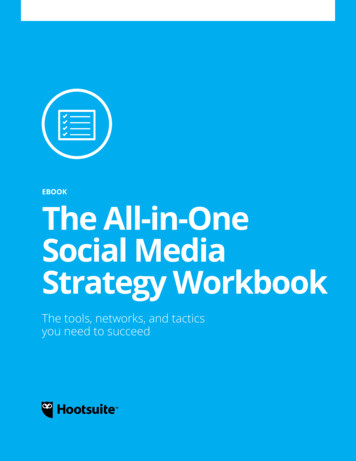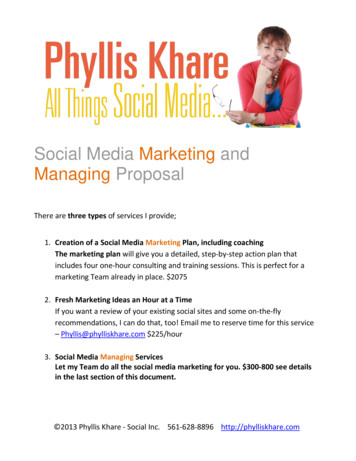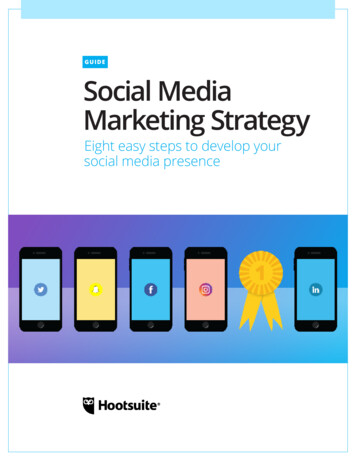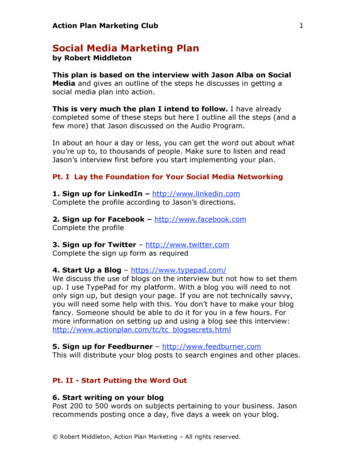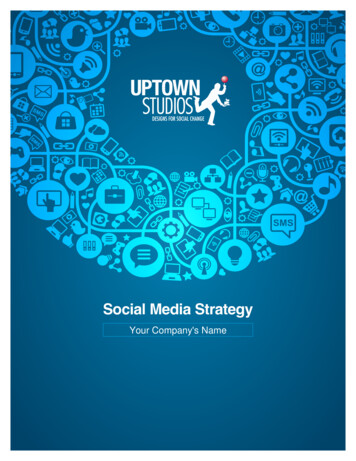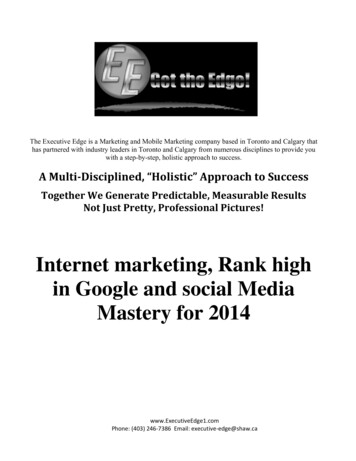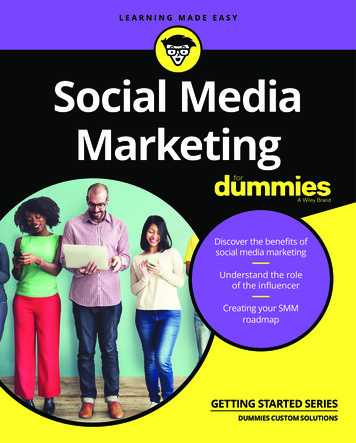
Transcription
Social MediaMarketingDiscover the benefits ofsocial media marketingUnderstand the roleof the influencerCreating your SMMroadmapGETTING STARTED SERIESDUMMIES CUSTOM SOLUTIONS
IN THIS CHAPTER»» Understanding social mediamarketing’s role»» Discovering the different rolesplayed by social media marketsand influencers»» Knowing where to find yourcustomers»» Finding your social mediamarketing campaign direction»» Remembering the keys to successUnderstanding SocialMedia MarketingWith nearly 280 million people using the Internet on a regular basis in theUnited States alone and approximately 2.9 billion users globally, surfing the web has become a mainstream social activity and, as a result,changed the way people interact, learn, and even purchase products. This shiftmakes social media one of the most influential forms of marketing today.As a modern marketer, it’s important that you focus your approach on the socialaspects of the web that help to increase brand awareness, encourage a networkof influencers, and strengthen your online reviews, all of which can help make orbreak your products sales.
Defining Social Media MarketingA discussion of any subject needs to begin with a definition, and so here’s theone for social media marketing: Social media marketing (SMM) is a technique thatemploys social media (content created by everyday people using highly accessibleand scalable technologies such as social networks, blogs, microblogs, messageboards, podcasts, social bookmarks, communities, wikis, and vlogs).Social media (which has probably been one of the most hyped buzzwords of thelast decade) refers to content created and consumed by regular people for eachother. It includes the comments a person adds at the end of an article on a website,the family photographs she uploads to a photo-sharing service, the conversationsshe has with friends in a social network, and the blog posts she publishes or comments on. That’s all social media, and it’s making everyone in the world a contentpublisher and arbitrator of content. It’s democratizing the web.SMM in the context of brand marketingBrand marketing focuses on building equity around a brand, its personality, andattributes. Customers purchase products based on the brand promise. Throughvarious forms of advertising and communications, the brand promise is broughtalive to generate awareness, build excitement, and get specific products includedin a consideration set. Mass media channels are typically used to build awarenessfor the brand, reposition it with more powerful attributes, or ultimately sell products. This will always be central to marketing efforts. All brands require significanteffort to penetrate a market and generate desire.SMM complements brand marketing in some key ways:»» SMM places extra emphasis on peer-to-peer marketing and allows forpeer-to-peer decision-making in a digital context.The focus is on understanding how consumers are interacting with each otheron social platforms versus how they’re interacting with the brand. Consumersare asked to do the marketing for the brand by layering their own voices andperspectives on top. The result is the socialization of a message or story in away that’s meaningful and relevant to their world.»» SMM rarely uses mass media, whether television, print, or radio.Interactive channels that allow for the socialization and redistribution of amessage are more important. But the brand cannot be simply pushedthrough the channels. Instead, invite consumers in the channels to experiencethe brand and make it their own.Understanding Social Media Marketing3
»» SMM is about becoming part of all media streams, across all channels,where consumers are responding to and discussing the brand messages.In many cases, they’re self-organizing these conversations on the fly. In otherinstances, they gravitate toward existing community hubs where the conversations are already taking place. These conversations can also take place onyour own corporate website.Learning about the Roles People PlayTo look at the framework of social media marketing, we need to look at the different roles played by those engaged in social media:»» Marketers: They publish and share content online to achieve an organiza-tion’s marketing and business needs. Today’s marketer looks nothing like themarketers of the twentieth century. Customers now own the brand conversation. The opportunity to interrupt and annoy those customers has dwindled.Customers now meet businesses on their own terms.»» Influencers: Several types of influencers contribute to the decisions custom-ers make. They may be everyday people who influence the consumer as hemakes a purchasing decision. Depending on the decision, the social influencers may be a wife (or husband), friends, peers at work, or even someone theconsumer has never even met in real life. Simply put, the people who influence a brand affinity and purchasing decision are the social influencers. Theymay exert this influence directly by rating products and commenting or bypublishing opinions and participating in conversations across the web.It isn’t enough to market to the consumer anymore; as a marketer, you have tomarket to your potential customers’ social influencers as well so that they in turninfluence either overtly or just by what they publish and share online. And that’swhat social media marketing is about.Changing roles of the social mediamarketerToday, many marketers are looking for a specific set of rules to follow to be successful. We can assure you that there aren’t any, but there are some guidelines.Following are some of the actions that social media marketers must take if theywant their company to compete successfully in the new social marketplace:Understanding Social Media Marketing4
»» Become the top persuader.When you lead a SMM team, you need to understand that persuasion is yourmost important tool. You persuade your team that you can help its membersachieve success, and you persuade your customer to buy your product.Before you influence, you need to figure out the persuasive message that willsell. When you do that, you can unleash the groups that influence your customers.»» Use a variety of distribution channels.The key mistake that some new social media marketers make is to focussolely on social media platforms to carry their message. This does half the job.Although it gets people’s attention, it doesn’t get them to the sale. For example, imagine that you have just tweeted about a solution for stain removal.Unless you provide a link to your product and a place for discussion andreviews, you have a missed opportunity. Draw a map of all your channels(blog, website, newsletter, and so on), and use it whenever you plan a newcampaign. You need a link to all your venues.»» Reinvent your strategy to emphasize value.Value is a secret weapon in this economy. When you boil away all the otheringredients of a product sale, you uncover value. This is a tricky conceptbecause value is in the eye of the beholder. Understanding what imparts thatvalue should underlie your entire marketing strategy. Think about your current SMM campaign. Are you focusing on features and benefits or on how theproduct makes your customer feel? For example, some companies focus onmaking people feel smart and sexy when they buy a certain model car. By thesame token, others may focus on models that emphasize safety and responsibility. If you understand the value, you can establish a bond with your buyer.»» Market to inspire.The globalization of our world via the Internet has given us a window intothe lives of others. It’s hard to ignore the poverty and disease that plaguemuch of the world’s population. Many companies are seizing the opportunityto use their businesses to help make an impact. SMM encourages awarenessof the connection we share with others. Think about how your business canparticipate.»» Create and curate content.Offering engaging content is a big part of any SMM campaign. You need aneditorial calendar that lays out your topics, creation tools, and deadlines. Youalso need to focus on curating content already published on the web.Becoming a trusted source of information is key to getting your customers tovisit often.Understanding Social Media Marketing5
»» Know when to resist the next shiny object.New web tools pop up daily. The best way to avoid being distracted is to writeyour objectives down. The last thing you want to say to yourself is, “Everyoneis using such and such, so we should use it.” Place your objectives in a prominent place and refer to them often. If they change, revise the document.But whatever you do, don’t try to do something on every social platform —you’ll quickly discover that you don’t have the tools, training, and — mostcritically — the resources to support all the tools.»» Be prepared to be wrong.This is a tough one. In your role as marketer, you want to lead your companyto successive victories. SMM is not a sure thing. You need to be prepared toexperiment and change course using the feedback that you get from customers. You may start with a small idea and develop it into a full-blown campaign.It is unlikely that you can start out with a very expensive big effort and nothave to correct along the way. When management and staff start out with thenotion that they are testing and experimenting, changes in direction won’tseem as shocking. This cuts down on wear and tear of the psyche for everyone. It also limits the risks to your core marketing efforts while you learn thisspace.Understanding the role of the influencerTo understand how social influence works, you need to look at how people areinfluenced in the real world, face to face. Social influence isn’t something new.Long before the web, people asked each other for advice as they made purchasingdecisions. What one person bought often inspired another to buy the same product, especially if the original purchaser said great things about the product. That’show human beings function; we’re influenced and motivated by each other to dothings. We’re social beings, and sharing information about our experiences is all apart of social interaction.How much a person is influenced depends on multiple factors. The product itselfis the most important one. When buying low-consideration purchases (those witha small amount of risk), people rarely seek influence, nor are they easily influenced by others. Buying toothpaste, for example, is a low-consideration purchasebecause each product may not be that different from the next one, and they’re allfairly inexpensive — so you won’t lose much money if you choose one that doesn’tfit your needs. On the other hand, buying a new car is typically a high-considerationpurchase (a purchase that includes a large risk). The price of the car, the maintenance costs, and its reputation for its safety all contribute to making it a highconsideration purchase, not to mention the fact that you want to identify with acertain brand versus another one. Social influence plays a much bigger role in carpurchases than in toothpaste decisions.Understanding Social Media Marketing6
Social influence matters with every purchase, but it matters more with highconsideration purchases than low-consideration ones. Most consumers realizethat when they’re making high-consideration purchases, they can make better andmore confident purchasing decisions when they take into account the advice andexperience of others who have made those decisions before them. That’s how influence works.Considering the types of influencersWhen discussing social media marketing, people often ask us whether this meansthat they should add product review features to e-commerce websites or advertise on social networks. Yes, product reviews and advertising are important, butthere’s more to social influence than those two things. When you think aboutsocial influence in the context of your marketing objectives, you must separatesocial influencers online into three types: referent, expert, and positional. These categories come from thinking that social psychologists John French and BertramRaven pioneered in 1959.As a marketer seeking to deploy social media marketing techniques, the first question to answer is this: Which social influencers sway your consumers as they makepurchasing decisions about your product? After you identify those social influencers, you can determine the best ways to market to them.Referent influencersA referent influencer is someone who participates on the social platforms. Theseusers are typically in a consumer’s social graph and influence brand affinity andpurchasing decisions through consumer reviews, by updating their own status andTwitter feeds, and by commenting on blogs and forums. In some cases, the socialinfluencers know the consumers personally. Social graph is a term popularized byMark Zuckerburg of Facebook and is used to describe the relationships that peoplemay have on a social network and how they connect to one another.Since the consumers know and trust their referent influencers, they feel confidentthat their advisers are also careful and punctilious. Since they’re people they trust,they value their advice and guidance over most other people. Referent influencersinfluence purchasing decision more than anyone else at the consideration phaseof the marketing funnel, according to various studiesExpert influencersA consumer who’s mulling over a high-consideration purchase might also consultan expert influencer. An expert influencer is an authority on the product that the consumer is considering purchasing. Also called key influencers, they typically have theirown blogs and huge Twitter followings and rarely know their audiences personally.Understanding Social Media Marketing7
Positional influencersA positional influencer is closest to both the purchasing decision and to the consumer. Called peer influencers sometimes, they are typically family members orpart of the consumer’s inner circle. They influence purchasing decisions mostdirectly at the point of purchase and have to live with the results of their familymember’s or friend’s decision as well.Influencing on digital platformsSocial influence impacts every purchasing decision and always has in some formor other. Each time people make purchasing decisions, they ask each other foradvice. Sometimes they depend upon an expert’s guidance, and in other cases,that advice comes from people they know.So why is influence such a big deal today? This is because Internet consumption,and social media consumption specifically, have hit the mainstream. Social mediatraffic referrals have risen dramatically in the last few years. Facebook, Pinterest,and Twitter have 21 percent, 7 percent, and 1 percent, respectively, of global referrals per Shareaholic (March 2014). These numbers show how much people are alsoacting on the influence of others — they’re visiting the websites that they’re beingtold to visit.People are making more and more purchasing decisions online every day. It’sas natural to buy a product online as it is to go into a physical store. People buyclothes and shoes online, not to mention high-consideration items such as computers, cars (yes, cars), and jewelry. But that’s not all. Not only are consumersbuying online, but thanks to social media, they’re also conversing, socializing, andinfluencing each other online on a scale never seen before.Call it a shift in web behavior, but the way people make decisions in the realworld is finally moving to the Internet in a big way. Social media platforms suchas Facebook, LinkedIn, Twitter, and YouTube are just a few of the places wherepeople are asking each other for advice and guidance as they make purchasingdecisions. Smart companies are realizing that they should no longer design theire-commerce websites to convince buyers to make purchasing decisions in isolation. Rather, they need to design the websites to allow consumers to bring theirsocial influencers into the decision-making process. As consumers, people expectand want that because that’s how they’re used to making their purchasing decisions. That’s why social media marketing matters today. People are influencingand being influenced by each other every day on the social network platforms,community websites, and destination sites.Understanding Social Media Marketing8
You may need to put a lot of effort into convincing your managers how importantthe social media platforms are. One of the best ways to communicate these ideasand techniques is by organizing lunch-and-learn sessions and bringing in external speakers who can walk your managers through the major social platforms andhow best to market on them. Sharing case studies from other brands always resonates well and goes a long way to establishing credibility.Researching Your Customers’Online ActivitiesWhen developing a social media marketing campaign or a broader, continuingprogram, determining what your target customers are doing on the Internet isimportant. Without this information, you can’t formulate a smart social marketing strategy. You’re simply shooting in the dark.There are several tools you can use to find out where your target customers aregoing online. Tools that help you research online activity fall into two basic categories: free and paid. You can simply register for and use the free tools. Paid toolsand services incur a charge and can get expensive very quickly. In this section, wediscuss some of the free tools:»» Blog search engines: These search engines crawl (sort through) just theblogosphere for the terms that you input. They search for those terms in theblog posts and the comments, and the searches generally include all publiclyviewable blogs on the Internet. If you just want to get a sense of the conversations in the blogosphere about a specific topic or brand, these search enginescan help you do that.»» Buzz charting: Similar to the blog search engines are the buzz charting tools.These tools focus on giving you a comparative perspective on how manydifferent keywords, phrases, or links are discussed in the blogosphere. Theysearch for the terms and then organize the responses into a chart, withthe x-axis being time and the y-axis the number of posts. Typically, you canchoose the duration of time for the x-axis.»» Forums and message boards: To understand online behavior in the socialweb, you must be able to scan the conversations happening in forums andmessage boards as well.Understanding Social Media Marketing9
»» Video and image search: For video search, you have to depend on a coupleof tools, because no single one truly captures all the videos created. All videosearches must begin with YouTube because it’s the largest video website, butyou should also look at Blinkx Video.On the image side, you’d want to search Instagram, Pinterest, Tumblr, Flickrand, to a lesser extent, Google Images. These tools are valuable for understanding broader trends, your consumers, and conversations about yourindustry and potentially your company, too.Note: Google Images also searches professionally produced and publishedimages, not just user-generated ones, so you might not get an accurate picture of what people are talking about.Creating Your SMM RoadmapAs with any other good marketing campaign, you need to construct a roadmap thatshows you where you are going and how you’ll get there. Here are seven steps thatyou can take to bulletproof your campaign structure. They are as follows:»» Define your objectives.»» Develop a powerful story/experience.»» Create an action plan.»» Craft the content path.»» Execute for influence.»» Create partnerships.»» Track the results.Define your objectivesThis may seem obvious, but it is amazing how many of us forget about articulating the objectives when it comes to a SMM campaign. Your objectives need to betightly defined, and they must be practical and actionable, too. Saying that theobjective of the campaign is simply to take a TV advertisement and make it go viralis definitely not enough.The objectives must also specify where you’re planning to run the campaign, whomyou’re targeting (which customers and which influencers), the duration of thecampaign, and how it synchronizes with other digital and offline marketing efforts.Understanding Social Media Marketing10
It is easy to forget that no SMM campaign happens in isolation. How you participate on the various social platforms is always a mirror of what you do and think inthe physical world. If you ignore that fact, you’ll lose your customers even beforeyou’ve had a chance to meaningfully engage with them.Develop a powerful story/experiencePeople’s expectations about how they will learn about your business/productshave changed completely. Since the Back button on the browser is ever-present,waiting to take users away from your website, you have a very short window toengage and educate. The days of posting a simple data sheet and a price are over.You have to work to communicate the intrinsic value of each offer.Also, since people want to know whom they are dealing with, you need to injectthe why into your business story. You need to let them know why you started yourbusiness and what you care about. The social aspect must be visible. The followingare stories you should consider telling during your campaign:»» Why we are running this campaign: Yes, you want to sell things, we understand that. But what is the larger picture? Are you contributing to charity,helping others be successful, providing a solution, or providing content thatdoesn’t currently exist? You have to be specific.»» What value the customer will get from participating: Customers wantsocial proof that others you have dealt with have had a great experience. Youneed to gather testimonial stories to share. If you can provide video of previous customers speaking, you have a way to demonstrate authenticity. Youalso need to show how your brand will either specifically improve customers’lives or contribute to their sense of worth in relation to their friends (otherwise they won’t share your content).»» People who are impacted/show visual stories: Provide visuals that tell astory. Well-known screenwriter Robert McKee has said that stories “unite anidea with an emotion.” Make sure that yours does.»» Who the hero is: Have a story about the person or thing that is leading thiseffort. It can be a product that works, a founder who wants to do good, and soon. Show that hurdles have been overcome.»» How internal staff feels about what they do: A recently produced commercial by General Electric shows children talking about what their parents do atGE. The message comes through loud and clear that not only are the employees proud of what they produce but their children are, too.Understanding Social Media Marketing11
Create an action planObviously, the actions you take are dictated by the length and complexity of thecampaign. Every campaign has special features and highlights that need showcasing. However, following are some things that are common to most SMM campaigns you’ll want to consider creating:»» A clear call to action.Decide what action you want the user to take, and make sure that everythingyou do supports that. If the user has to sign up for something, display thesign-up process at front and center at all times.»» Hashtags and other tools.Most SMM campaigns create a hashtag for Twitter so that people canfollow the conversation. A hashtag has the number sign (#) and a wordor phrase related to the project. For example, a 2011 campaign to feedpeople on Thanksgiving was started by Pepto-Bismol with the hashtag#HelpPeptoFeedAmerica. Whenever someone retweeted the message withthat hashtag, the makers of Pepto-Bismol donated money to hunger relief.»» A venue for crowdsourcing.Are you going to create your own web page for people to share and submittheir comments, or will you use the current platforms? Decide whether youwant to create a Facebook page or a community on your own website oranother third-party one like Tumblr. There are pluses and minuses to eachchoice. If it is important to own the content, by all means create your own. Justremember that getting people to participate is easier where they normallyhang out. A new venue could be an impediment.»» Content that can be shared.The key to every great SMM campaign is creating content that gets attention.If you are a small business and can’t afford to create something splashy, youcan still do a video and create PDF posters, contests, and graphics. Look at allthe content you have already created, and see what you can repurpose. Ifdoing so makes sense, have your customers create content, and pick awinner.Craft the content pathWhen creating SMM campaigns, people often forget to map out where their actualtouch points will be and how they will look. It’s not enough to say, “We’ll send outa tweet with a link.” You need to be specific about it. You need to document thatUnderstanding Social Media Marketing12
you will send out three tweets a day at 9 a.m., 5 p.m., and 9 p.m., say, with certaintext and a link.Your preplanned content is only the first part of what you will be doing. You haveto also organically create messages that respond to the ongoing campaign to makeit real. When people post something about your campaign on Facebook or Twitter,make sure to respond to it in a reasonable amount of time, which should typicallybe no more than 12 hours later at the very most. The preplanned items are just thestarting point. Social marketing means reacting to real-time events.Execute for influenceTraditionally, most campaigns have focused on getting a potential customer totake a specific action or to view a specific brand message. The focus has alwaysbeen on that individual engaging with the brand in some form. However, with aSMM campaign, you need to design for sharing, influencing, reciprocity, and socialcurrency.Unlike most other campaigns, a SMM campaign needs to accomplish two objectives concurrently:»» It needs to engage the individual who’s being targeted via the campaign.This is similar to any other type of digital marketing campaign. You want toengage with your target audience in a specific fashion and solicit a specificresponse.»» You also need to design the campaign so that the target person sharesor discusses it with someone else.Sharing is the social currency element. The person should feel that by sharingthe campaign with someone else, he derives greater value from it. Thisgreater value could be something as tangible as further discounts or something as intangible as status among his peers. The point is that the morepeople he shares the campaign with (or discusses it with), the more value hegenerates from it. In this sense, the campaign takes on a network effect, withits value growing each time someone participates.Create partnershipsFew SMM campaigns are successful in isolation. A more traditional digital campaign, which is based on display and search advertising, comes together througha series of partnerships between the agency, the advertiser, and the publisher,Understanding Social Media Marketing13
and the same is true of a SMM campaign. However, in this case, the participantsvary slightly. Rather than have a regular publisher, you have the social platform tocontend with. Your campaign must be in compliance with that platform’s policies;otherwise, you can’t run on that platform. For example, Facebook and YouTubehave strict terms of service regarding the type of advertising that can appear ontheir platforms.The platform players aren’t the only things you have to take into consideration.With most large brands, ad hoc user groups that have a sense of ownership overthe brand or product category spring up on the social platform where you’re planning to run the campaign.For example, on Facebook, if you were to search for “Ford,” you’d find not justthe Ford Motor Company page, but literally hundreds of pages created by and forpeople interested in the Ford Motor Company. If you’re a marketer at Ford, whenyou’re planning a SMM campaign on Facebook, it’s not enough to talk to Facebookand your own agency about the campaign. For it to be a truly successful SMM campaign, you must engage with these ad hoc groups when the campaign is starting.They can be your biggest marketers, helping the campaign succeed. On the otherhand, if you upset them, they can turn into saboteurs.Track the resultsYou can measure a SMM campaign in a lot of different ways. The best methoddepends on the objectives, the targeted audience, and the social platform on whichthe campaign is running. But you must determine what you’re going to measureand how before you run the campaign. Otherwise, you’re never going to knowwhether it’s a success. SMM campaigns often spiral out of control, and the law ofunintended consequences starts applying.It’s also important to measure a baseline of online activity before you begin theSMM engagement and decide what to measure. The baseline helps you determinehow successful your campaign is relative to the level of conversations and onlineactivity before running it.You must measure not just how many people you reach or who is aware of yourcampaign but also the following: the influence generated; the brand lifts (increasedawareness of the brand across key brand attributes); and, most important, whetherany of this effort led to purchases. With the measurement tools in the marketplace(many of which are free or close to free), you can easily track your SMM campaignUnderstanding Social Media Marketing14
to the point of sale on the website or potentially even in a physical store. The measurement tools that exist on the social platforms are getting stronger and strongerby the day, too. Don’t hesitate trying to measure this.Participating — Four Rules of the GameMany different factors can make or break a SMM campaign, and sometimes it’seven just a matter of luck. But fo
To look at the framework of social media marketing, we need to look at the differ-ent roles played by those engaged in social media: » Marketers: They publish and share content online to achieve an organiza-tion’s marketing and business needs. Today’s marketer looks nothing like the marketers of the twentieth century.File Size: 2MBPage Count: 18



